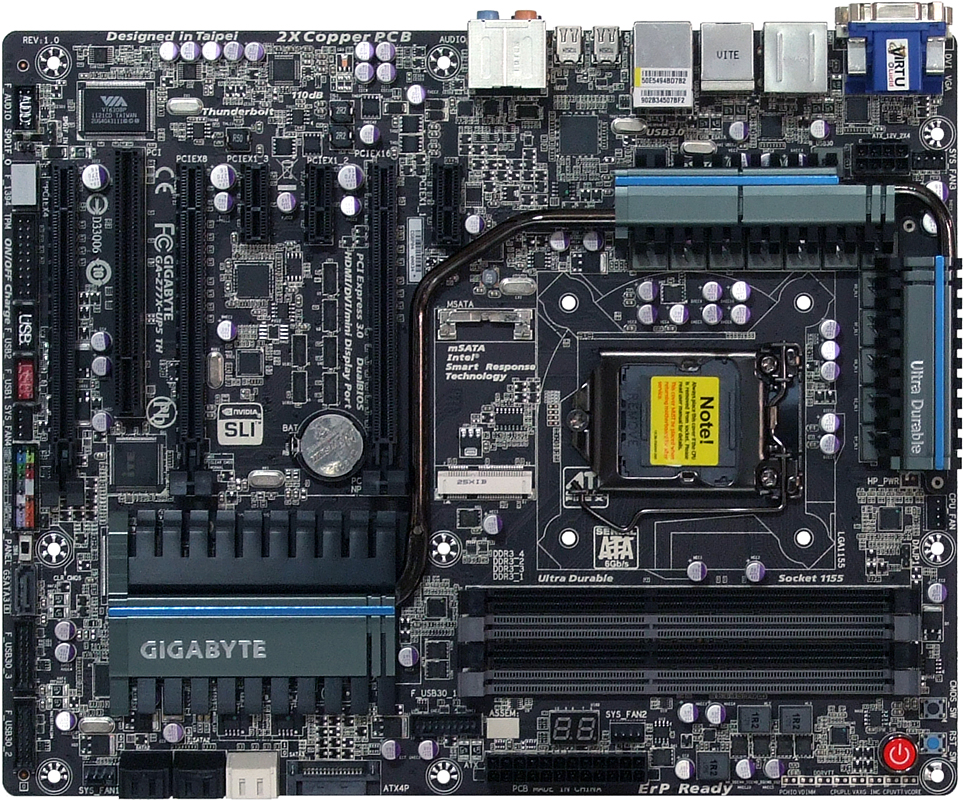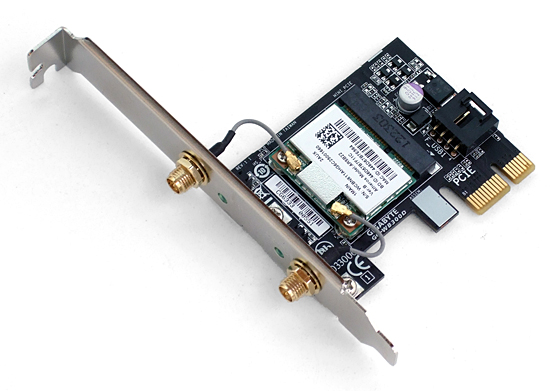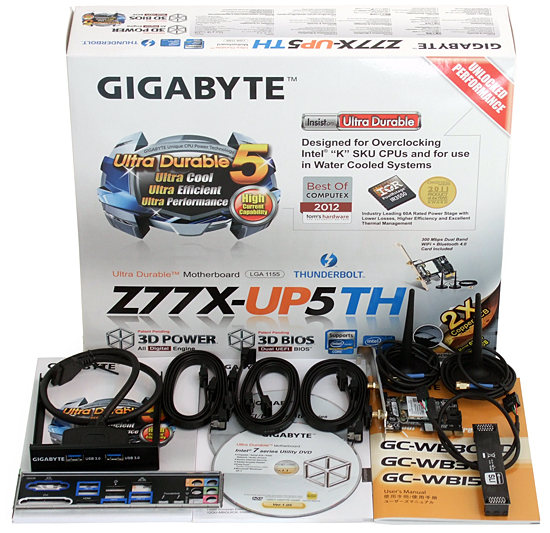Six $220-280 Z77 Express-Based Motherboards, Reviewed
Expanded graphics card support, enhanced on-board features that include Thunderbolt on some models, and more-robust voltage control are all good reasons to consider paying a little extra for a higher-end motherboard. Today we examine five top choices.
Gigabyte GA-Z77X-UP5 TH
Gigabyte’s exclusive feature for today’s round-up is a dual-port Thunderbolt controller, which also supports two monitors as long as the DVI-D connector is empty. Of course, it also supports two chains of storage devices or whatever else affluent enthusiasts connect to the PCI Express-based external interface. Anyone who would rather hold off on $40 cables might be just as happy with the Z77X-UP5 TH’s selection of four back-panel USB 3.0 ports, HDMI, DVI, and VGA outputs.
We’re still trying to wrap our heads around the presence of VGA output on high-end boards. It's a little easier to explain the lack of two gigabit Ethernet controllers by the fact that Intel's Thunderbolt controller eats half of the Z77 Platform Controller Hub's PCIe 2.0 lanes. In the face of a lot less PCI Express connectivity, Gigabyte's engineers were forced to put all three PCIe x1 slots on a four-lane PLX bridge.
Gigabyte certainly didn’t want to give up any bandwidth for discrete graphics cards, though we probably would have tolerated an 8732 bridge in exchange for more PCIe performance elsewhere. As it is, anyone who wants to populate the bottom x16 slot will find that doing so knocks the board into x8/x4/x4 mode. Don't even bother if you're trying to upgrade a machine with a Sandy Bridge-based CPU; you need an Ivy Bridge-based chip to support that kind of lane division.
With those limitations in mind, PLX Technology's 8732 PCI Express switch looks like it would have been a better move for Gigabyte. And using it would have given the company's designers a lot more flexibility in choosing PCIe x1-based features.
The Z77X-UP5 TH’s layout is good overall, with one of its two USB 3.0 internal headers found above the top graphics card slot where it won’t block anything. The top and middle PCIe x16 slots are also separated by three spaces to assist GPU cooling, and the Port 80 diagnostics display is located by the memory slots where it can’t get blocked by a processor or graphics card heat sink.
On the other hand, the second USB 3.0 internal header is found below the bottom graphics slot, and using it would prevent the insertion of most performance-oriented graphics cards. A SATA 6Gb/s connector placed along the bottom edge seems even more wasteful in light of the fact that mSATA is shared with one of the more conveniently-located forward-facing ports.
Most builders don’t use the top PCIe x1 slot, but Gigabyte gives them a good reason to with its Wi-Fi/Bluetooth card. The Wi-Fi side is PCIe, while the Bluetooth radio unfortunately requires connecting an internal cable to one of the Z77X-UP5 TH’s front-panel USB 2.0 headers.
Get Tom's Hardware's best news and in-depth reviews, straight to your inbox.
The Z77X-UP5 TH includes a very nice-looking USB 3.0-to-3.5” external bay adapter, six SATA cables, the Wi-Fi/Bluetooth card with dual antennas, a USB 2.0 link cable for the Bluetooth controller, and a single Nvidia SLI bridge.
-
roberta As u have reviewed SIX (6) motherboards, the article's title should be:Reply
"Six $220-280 Z77 Express-Based Motherboards, Reviewed" -
mayankleoboy1 No SATA and USB tests ? data transfer speed differences will typically be noticable in everyday usage.Reply
Also, the time taken to show the windows loading screen/ BIOS page.. -
admit it.Reply
you really liked the black/grey dimms and PCI slots of the gigabyte better than the blue/black of the MSI! -
Crashman robertaAs u have reviewed SIX (6) motherboards, the article's title should be:"Six $220-280 Z77 Express-Based Motherboards, Reviewed"Let's see what the article says:ReplyThe one motherboard in today’s line-up with a 48-lane PCIe 3.0 bridge is ECS’ Golden Z77H2-AX. Unfortunately, this platform climbed $40 beyond the budget limit of today’s round-up in the time we've been reviewing it. We're tired of seeing board vendors playing pricing games based on our review schedule (this isn't the first time we're seeing a curiously-timed price move). So, since we put the work in to review ECS' submission, we're including our already-gathered data and simply withholding the board from any award candidacy.
mayankleoboy1No SATA and USB tests ? data transfer speed differences will typically be noticable in everyday usage.Also, the time taken to show the windows loading screen/ BIOS page..Would have covered windows load time except that it wasn't markedly different. That is, after disabling empty SATA controllers. If you count the time that it takes to get the "No Device Found" error on boards that have extra SATA controllers, you're penalizing a board for having more features.
Andrew Ku tests drive controllers. I'm trying to get him to "write the book" on controller performance, since dozens of boards use only a few different controllers. As for testing things like Z77 controller performance on board A vs Z77 controller performance on board B, it's a waste of time unless something is broken. So the article looked for "broken stuff". See the red bar on the first chart:
http://www.tomshardware.com/reviews/z77x-up5-th-z77a-gd80-z77-oc-formula,3305-22.html
With nothing broken, there's no excuse to test the Z77 controller six times. Back to me begging Andrew Ku for a comprehensive comparison of every SATA controller currently available on mainstream-brand enthusiast boards.
-
JeanLuc Arghh! Why the hell are you overclocking the base clock on Z77!! That will most likely cause permanent damage to your CPU.Reply -
You left out a key aspect for overclockers which is vcore offset.Reply
This allows ocer's to achieve higher overclocks while still retaining the power saving functions, instead of being forced to either reduce the overclock, or be forced to run high voltage 24/7.
MSI doesn't have this key feature. -
Onus I would think that the Sabertooth's five year warranty merits at least a mention in any value conclusion.Reply
-
luciferano JeanLucArghh! Why the hell are you overclocking the base clock on Z77!! That will most likely cause permanent damage to your CPU.Reply
Overclocking the BLCK is very unlikely to cause any damage, it's just likely to not give much of a stable overclock. -
Crashman jtt283I would think that the Sabertooth's five year warranty merits at least a mention in any value conclusion.I actually missed that, having checked the lesser brands just to make sure those still had their three year warranty. Will add it.Reply




